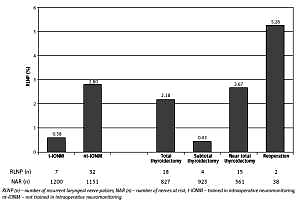Introduction
Recurrent laryngeal nerve palsy (RLNP) remains the most dreaded complication in thyroid surgery. Possible mechanisms leading to RLNP include nerve transection, ligation or clamping, thermal injury as a side effect of energy-based hemostatic devices, vacuum pressure, ischemia and – most commonly – traction on the nerve and forced manipulation at the region of Berry’s ligament [1–5]. An inappropriate intubation, postoperative cicatricial tissue formation and haematoma are also potential causes of nerve dysfunction.
To facilitate recurrent laryngeal nerve (RLN) identification, intraoperative neuromonitoring (IONM) has been developed. Whereas the impact of IONM on RLNP is so far not well documented, there is evidence of the usefulness of IONM in reoperations on the thyroid gland and it has been advised routinely in thyroid and parathyroid surgery to better understand anatomy [6, 7].
Since the frequency of RLNP makes it difficult to demonstrate the usefulness of IONM in reducing the number of RLNP in prospective studies, we decided to perform a retrospective cohort study. As IONM is not routinely used in our country, we focused on the influence of training in IONM on RLNP in thyroid surgery. We decided to analyse the data from our department to better evaluate the difference between the results of operations performed by surgeons trained (t-IONM) or not trained in IONM (nt-IONM). The main goal of the study was to determine whether training in the neuromonitoring system by itself has any impact on the RLN injury rate due to performed thyroidectomies. Secondly, we wanted to verify whether there is any statistically significant difference in the risk of RLNP in subgroups of patients undergoing surgery with or without IONM assistance, the risk of RLNP associated with the disease (carcinoma, benign goitre, Graves’ disease) and the risk of RLNP depending on the extent of the surgery (total, near total, subtotal thyroidectomy) as well as risk of RLNP due to primary vs. secondary surgery.
Material and methods
Patient selection
The retrospective analysis of the data collected according to medical documentation of patients with confirmed RLNP due to thyroidectomy performed in the 1st Department of General and Endocrine Surgery, Medical University of Białystok Clinical Hospital, Poland, is presented in the work. In the years 2005–2012, 1235 patients from 19 to 87 years of age (mean age: 49.5) underwent this surgery and the group contains 86.3% women (1065 of the patients in the mean age of 49.6) and 13.7% men (169 patients with the mean age of 49.2). The sole exclusion criterion was diagnosed psychogenic postoperative aphonia, which was found once, so the patient could not be finally included in the RLNP group because of overdiagnosis of palsy (Figure 1, Table I).
Figure 1
Patient selection
Exclusion criteria: *psychogenic aphonia. nt-IONM – surgeons not trained in intraoperative neuromonitoring, t-IONM – surgeons trained in intraoperative neuromonitoring, RLNP(+) – recurrent laryngeal nerve palsy present, RLNP(–) – recurrent laryngeal nerve palsy absent.
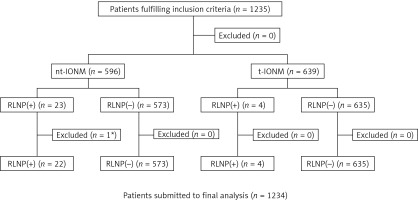
Table I
Descriptive characteristics of analysed cohort of patients
Three different backgrounds of thyroid pathologies were suspected according to clinical symptoms and fine-needle aspiration (FNA) biopsy findings before proposed surgery: benign nodular and/or cystic goitre, Graves’ disease and malignant neoplasia which was to be confirmed according to final postoperative histopathological tissue examination. The surgery was always fixed after endocrinologist ambulatory consultation. It was indispensable to have up to date ultrasound imaging and FNA biopsy results to characterize the volume of the goitre and to plan the extent of the surgery. In the group there were no needs for any supplementary preoperative diagnostic imaging (neither CT scans nor MRI).
Directly before hospitalization once again physical examination including neck palpation and endocrine hormone levels (TSH, fT3 and fT4 blood analysis) were ordered. As soon as the euthyroid state was reaffirmed thyroidectomy was scheduled. Nevertheless, in 63 cases surgery was requested despite hyperthyroidism (5.1%).
Also, co-existent morbidities such as hypertension, diabetes, and dyselectrolytaemia were investigated and/or corrected before qualification for general anaesthesia. Finally, the day before planned surgery an ENT doctor consultation was provided. Videolaryngoscopy was not accessible at the ENT Department. Indirect laryngoscopy in a Clark mirror was routinely performed for larynx evaluation. Particular emphasis was put on the presence or absence of vocal cord movements during phonation and within deep breathing as well as dynamics of the present motion, which was described every time in proper documentation.
Surgical procedure
After induction of general anaesthesia and endotracheal intubation, patients’ position on the operating table was rearranged. Shoulders were elevated on a rolled sheet to provide optimal intraoperative conditions when the neck is maximally elongated, the larynx is pulled out more superficially and the thyroid is more accessible. Once a short period of induction of anaesthesia with input of succinylcholine had finished, no additional muscle relaxants were used if IONM was planned. The conventional approach by horizontal neck incision placed 1 cm below the cricoid cartilage was done usually with its length between 4 and 10 cm depending on the goitre volume. In selected patients who were being prepared for intraoperative neuromonitoring (182 patients necessitating 357 lobe resections) needle electrodes were placed intraoperatively in standard points: the first one by puncture through the cricothyroid membrane to the thyroarytenoid muscle (vocal fold) and the second – the ground one – contralaterally into the subcutaneous tissue of the sternoclavicular area. During the analysed period a sound-based needle IONM system was used (CLEO nerve monitor, INOMED, Emmendingen, Germany) with parameters of medium frequency and currency amplitude of 1.0 mA. We were following a 4-step protocol with vagus and RLN stimulation (before and after RLN dissection): L1-V1-R1-R2-V2-L2* (*postoperative laryngoscopy if any vocal cord abnormality such as stridor, hoarseness, aphonia or cough was suspected). An audio feedback signal was received as soon as the RLN was identified. Staged thyroidectomy was not a routinely followed strategy in our centre those days. In case of LOS, which occurred several times, we continued the second side surgery. The appropriate remarks were made in the operative protocols.
In the staff of 8 main operators, four of them were trained in intraoperative neuromonitoring before the year 2005, from when we decided to build a database of the analysed group (t-IONM), and the next four surgeons were not familiar with the system (nt-IONM). Every operation was performed by one surgeon, two assistants and one scrub nurse.
All surgeons underwent basic internal training held at our department after the device was purchased. T-IONM surgeons successfully completed additional structured training in one of two reference centres (either in the Department of Surgery, Martin Luther University, Halle-Wittenberg Medical Faculty, Halle/Saale, Germany or in the Department of Endocrine Surgery, Third Chair of General Surgery, Jagiellonian University College of Medicine, Krakow, Poland). It started with theoretical preparation and familiarity with the international IONM guidelines [8], then it was based on hands-on training and active participation in surgery (on average 60 assists for thyroidectomy with IONM application).
As relates to case-volume, we found no statistically significant difference between the two groups (p < 0.05). The mean case-volume in thyroidectomy was 43 per year in the t-IONM group and 41 in the nt-IONM group. In 2012 the mean age of t-IONM was 47.5 (41–53) and 52.5 (44–65) for nt-IONM (not statistically significant). However, they were all (t-IONM and nt-IONM) specialists with over 15 years of experience in thyroid surgery.
Although four operators were trained in the technique, only three of them used the tool, whereas one surgeon had abandoned this practice at the very beginning (171 procedures with IONM per 644 procedures performed by t-IONM; Figure 2).
Figure 2
Descriptive characteristics of patients
NAR – nerves at risk, t-IONM – surgeons not trained in intraoperative neuromonitoring, nt-IONM – surgeons not trained in intraoperative neuromonitoring, IONM – intraoperative neuromonitoring applied, IONM – intraoperative neuromonitoring not applied, RLNP – recurrent laryngeal nerve palsy, RLNP(+) – recurrent laryngeal nerve palsy present, RLNP(–) – recurrent laryngeal nerve palsy absent.
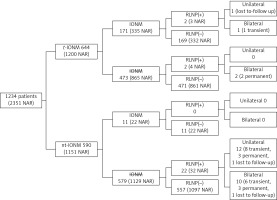
A particular case was the patient presenting bilateral RLNP after surgery performed by t-IONM with IONM use. That was a 74-year-old woman operated on in 2006 for giant recurrent retrosternal goitre with tracheal compression and stricture. Goitre volume, scar tissue and massive adhesions made the operation extremely difficult. Due to tracheomalacia a consulting ENT surgeon decided intraoperatively to perform tracheostomy.
Among 1234 procedures performed in the group of patients submitted to the final analysis 2351 thyroid lobes were removed. The total number of nerves at risk of injury (NAR) was equal to the number of resected lobes as no pre-existent RLNP was found in preoperative ENT consultations. During the primary operation which was indicated for 1211 patients (2313 of NAR) the lobes were resected usually totally (35.8% of total number of removed primary lobes) or subtotally (40%). Near total thyroidectomies also included subcapsular procedures. Among 23 patients who underwent a secondary operation 38 nerves at risk were patiently looked for.
There were not any unexpected perioperative complications due to IONM application in the analysed group.
Postoperative control
During the analysed period the routine of the department was an elective preoperative vocal cord assessment before the surgery and a selective postoperative laryngeal examination. To confirm or exclude the RLN lesion and to describe the laterality of pathology ENT consultation was demanded at postoperative day 0 to 1, every time complications were suspected, either within the first minutes after extubation in case of severe dyspnoea or within the first postoperative day when clinical signs such as hoarseness, aphonia or cough needed verification. Feedback was given again by indirect laryngoscopy and voice quality analysis. Only such symptomatic patients were consulted during their stay in the department; asymptomatic ones were addressed to the outpatients’ clinic for a routine ENT examination.
We accepted a 12-month period as a time criterion for definition of permanent palsy. This definitive RLN motor function loss without any hope for recovery after pharmacological treatment or voice rehabilitation was certified by phoniatricians. The follow-up information was gathered together with each patient throughout 3 years after surgery. We lost to follow-up 3 patients presenting postoperative RLNP because they had never appeared at a routine postoperative consultation and/or misleading contact data were found in the medical documentation.
Statistical analysis
For statistical analysis the χ2 test of independence and Fisher’s exact test were used to check the strength of association between qualitative features. Univariate logistic analysis was done and a multivariate model was created. The results were considered statistically significant at a level of p < 0.05. For calculations we used the packages Statistica 10.0 by StatSoft and Stata/IC 12.1 by StataCorp LP.
Results
Complication in the form of RLNP or paresis was observed in total in 26 (21.1%) patients in whom 39 nerves were damaged compared to 2351 of all NAR (1.66%) (Figures 1, 2).
T-IONM surgeons had performed in total 644 (52.2%) thyroidectomies while nt-IONM surgeons 590 ones. Palsies occurred 4.9 times (OR = 0.21) more often in teams guided by nt-IONM surgeons (Table II). A statistically significant difference was observed in these groups as from all 39 injured RLNs, 7 were damaged by t-IONM surgeons (per 1200 NAR) and 32 (per 1151 NAR) by nt-IONM surgeons (p < 0.001) which gives the incidence of this complication at the level of 0.58% vs. 2.8%, respectively (Figure 3). In the analysed cohort bilateral RLNP was caused more often by t-IONM surgeons, contrary to unilateral RLNP, which occurred mainly in the subgroup of nt-IONM surgeons (Figure 2).
Figure 3
Recurrent laryngeal nerve palsy (RLNP) rate in compared groups of surgeons: t-IONM – trained in neuromonitoring, nt-IONM – not trained in neuromonitoring (RLNP in surgeon group/NAR in this group) and general comparison (t-IONM + nt-IONM) of RLNP rate in particular groups according to surgery extent (RLNP in thyroidectomized group/NAR in this group)
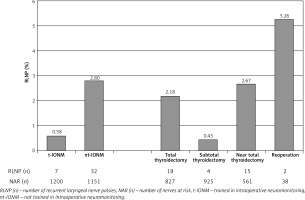
Table II
Statistical analysis. Univariate logistic analysis results and multivariate model describing association between recurrent laryngeal nerve palsies performed by t-IONM and nt-IONM as well as risk of RLNP in particular surgery types
Intraoperative neuromonitoring was planned for 182 (14.7%) operations, among which twice it finished with RLNP, which corresponds with 357 NAR exposed and 3 injured nerves (0.84% of NAR). Without intraoperative neuromonitoring aid 1994 NAR were exposed and 36 of them were damaged (1.81%), which is not statistically significant compared with the group where IONM was applied (p = 0.189).
Higher risk of RLNP was expected in 91 patients (172 NAR) with thyroid carcinoma but finally palsy arose in only 3 of them (4 RLNP; 3 embarrassed by t-IONM), whereas surgery for benign reasons (including Graves’ disease) in 1143 patients (2179 NAR) finished with RLNP in 23 patients (35 RLNP: 4 RLN injured by t-IONM; p = 0.477).
There were 70 NAR with diagnosed Graves’ disease: 24 patients (44 NAR) operated by t-IONM and 15 (26 NAR) by nt-IONM whereas Hashimoto disease diagnosed in 1 patient (2 NAR) was operated by an nt-IONM surgeon. In all these cases (Graves’ and Hashimoto) no RLNP occurred.
During reoperation (38 NAR, 1.6% of all NAR) 2 nerves were paralysed bilaterally in 1 patient (5.1% of all RLNP); t-IONM surgeons removed 17 lobes injuring 2 nerves and nt-IONM surgeons removed 21 lobes without this complication. With our outcomes there were no statistically significant differences between the group of RLNP caused by t-IONM and nt-IONM surgeons in higher risk subjects (malignancy, reintervention). However, reoperation appears to carry triple higher incidence of overall RLNP (5.26% after secondary and 1.6% after primary surgery).
Considering the extent of the primary surgery the majority of RLNP were observed due to total (48.7%) or near total (40.5%) thyroidectomy. During total thyroidectomy 35% of all nerves at risk were exposed and 2 of them were affected (2.18%; Figure 3). In this type of procedure t-IONM surgeons removed 597 lobes and 3 nerves were paralysed comparedto 230 lobes resected and 15 RLNP caused by nt-IONM surgeons (0.5% vs. 6.5%). In near total thyroidectomy, 561 lobes were removed (24%) where 15 nerves were sacrificed (2.67%; Figure 3); t-IONM surgeons caused 1 RLNP for 275 removed lobes and nt-IONM surgeons 14 RLNP for 286 lobes (0.36% vs. 4.9%). Moreover, in both these types of thyroidectomy lower risk of RLNP was observed when they were performed by t-IONM (p < 0.001; Table III).
Table III
Risk of RLNP in association with training of surgeons in intraoperative neuromonitoring (t-IONM vs. nt-IONM) in different types of primary thyroidectomy
| Variable | t-IOMN | nt-IONM | P-value |
|---|---|---|---|
| Total thyroidectomy: | |||
| RLNP(+) | 3 | 15 | |
| RLNP(–) | 594 | 215 | < 0.001 |
| Near total thyroidectomy: | |||
| RLNP(+) | 1 | 14 | |
| RLNP(–) | 274 | 272 | < 0.001 |
| Subtotal thyroidectomy: | |||
| RLNP(+) | 1 | 3 | |
| RLNP(–) | 310 | 611 | NS |
The safest intervention seems to be subtotal thyroidectomy (10.8% of all primary palsies), where among 925 nerves (40% of all NAR) only 4 were damaged, once by a t-IONM surgeon (for 311 NAR) and 3 times by a nt-IONM surgeon (for 614 NAR). In addition, comparing this subgroup with total thyroidectomy the risk of RLNP is over 5 times lower (OR = 0.2, p < 0.003; Table II).
In the created multivariable logistic regression model, with fixed other parameters, the risk of RLNP is over 7.5 times lower after thyroidectomies performed by t-IONM compared to nt-IONM. Moreover, the risk of RLN injury is almost 10 times higher in total thyroidectomies in relation to subtotal thyroidectomy, with fixed other parameters, whereas it is not statistically significant compared with near total thyroidectomy and reoperation (Table II).
One year after the operation we estimated temporary palsy for 15 patients which means 56.4% of all RLNP (22 RLNP) where 2 were performed by t-IONM surgeons vs. 20 performed by nt-IONM surgeons (Figure 4). The recovery was noted usually within 2–3 months of pharmacological treatment and voice rehabilitation. However, after statistical analysis of followed-up patients presenting RLNP we did not find the superiority of training at a statistically significant level in association with the gravity of palsy (Table IV).
Figure 4
Persistent and temporary recurrent laryngeal nerve palsy expressed in nerves number (n) and palsy rate (in % of a total number of RLNP) in patients operated by surgeons trained and not trained in neuromonitoring
t-IONM – surgeons trained in intraoperative neuromonitoring, nt-IONM – surgeons not trained in intraoperative neuromonitoring, RLNP – recurrent laryngeal nerve palsy.
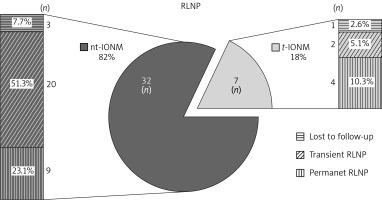
Table IV
The association between the time of recurrent laryngeal nerve palsy (temporary vs. permanent) and training of surgeons in intraoperative neuromonitoring (t-IONM vs. nt-IONM). To analysis were taken nerves at risk of patients who were seen during at least 1 year of phoniatrics observation
| Gravity of RLNP | t-IOMN | nt-IONM | P-value |
|---|---|---|---|
| Temporary | 2 | 20 | |
| Permanent | 4 | 9 | 0.12 |
Discussion
Advantages of IONM are still widely debated and there is no unambiguous evidence for or against its usefulness in clinical reduction of the RLNP rate [2, 9–13]. Even if there were published some data that IONM reduces the transient but not the permanent RLNP rate, several limitations of IONM persist because of abundant probable reasons for the signal loss, such as RLN extralaryngeal anatomical variations, as well as equipment defects, wrong monitoring setup, incorrect electrodes’ placement, muscle relaxant, presence of shunt stimulus, etc. [4, 8, 14]. Thus, most studies report a high negative predictive value of IONM (92–100%) but also a low and unstable positive predictive value of 10–100%, which divines no postoperative voice changes when the signal feedback is registered [2, 4, 15]. Likewise, the IONM system used in our study (CLEO, the only accessible tool in our hospital in those years) was based on acoustic signalling only whilst visual EMG curve analysis provides much more information for nerve prognostication. Moreover, it was not possible to analyse signal amplitude or latency.
Most of the limitations of IONM were proved to be avoidable by correct training in IONM. Chiang et al. showed indeed in 2010 that the lack of standardization in use of this surgical adjunct is believed to be the main cause of signal loss and false IONM results bringing higher risk of RLN injury by misleading information. As a solution he proposed pre- and postoperative vocal fold movement registration, laryngofibroscopy guided electrode placement and a 4-step procedure of IONM to test the vagus nerve and RLN (before and after RLN dissection). In his study, it significantly reduced the RLNP rate in the analysed groups from 6.4% to 0.8% [4]. Thus, a weak point of our study is postoperative laryngoscopy, which was performed only for symptomatic patients on day 0 or day 1 and not for everybody.
Even if there is a belief that experienced surgeons are more unlikely to finish their surgery with RLNP, some data show that if a trainee is supervised by a senior specialist there is no significant difference in this complication’s incidence [1, 16, 17]. It is also reported that the routine use of intermittent IONM for thyroidectomy increases the safety of operations performed by residents with the RLNP rate comparable to that seen after procedures completed under supervision of an experienced surgeon [17].
The main motivation for IONM usage is “medical-legal protection” and “increased confidence” [18] as it helps in RLN dissection, and reduces nerve manipulation and the risk of transient palsy. Furthermore, it indicates the point of potential nerve injury, and is helpful in case of excessive bleeding and in decision-making [2, 5, 8, 14, 19, 20]. However, the procedures with a neuromonitoring device prolong the operating time and many surgeons trained in IONM do not use it for each surgery but only in selected cases or they abandon it completely [21], as in our study.
It is reported that higher surgeons’ caseload and more conservative surgery are safer [1]. That coincides with our outcomes where we have proved that in extensive procedures where the nerve is exposed to the maximum, particularly good training effects are observed.
Even if experience with IONM helps with RLN identification and the routine use of IONM by trainees in thyroid surgery builds self-confidence and increases safety of operations [22, 23], routine visual nerve identification continues to be the gold standard in prevention of RLN injury and its gentle remains obligatory and cannot be replaced by IONM alone. However, we agree with Henry et al. [24] that to date, intermittent IONM has not achieved a significant level of RLN injury reduction, as shown by the meta-analysis conducted by Pisanu et al. [13]. However, most recent developments of IONM technology including continuous vagal IONM and the concept of staged thyroidectomy in case of loss of signal on the first side in order to prevent bilateral RLN injury may provide additional benefits which were beyond the scope of this study and need to be assessed in further prospective multicenter trials [24].
In conclusion, training in IONM significantly reduces the risk of RLN damage. Total or near total thyroidectomies are associated with greater danger of RLNP, particularly when they are performed by nt-IONM surgeons. We failed to demonstrate the influence of IONM on the rate of RLNP.


